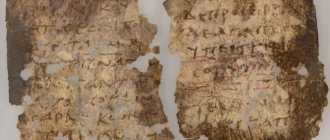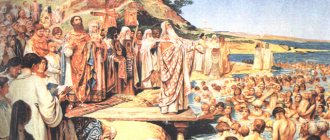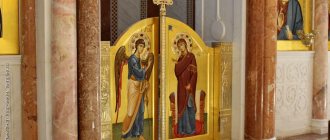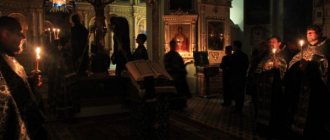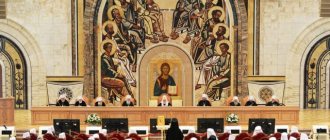Prohibitions
Thanks to such a strong campaign against the appearance of the religious document, at the end of November 1824 the Decree of the Holy Synod came into force. He prohibited the printing and distribution of Philaret's catechisms until further notice. The reason for the ban was declared to be the inadmissibility of translating the Lord's Prayer, the Creed and the 10 Commandments into Russian, called the “common dialect.” In 1825, the catechism of Metropolitan Plato was reissued. It must be said that this work was first published in 1786 and went through seven editions. The last of them was positioned as a counterweight to Filaret’s work. In Plato's manual, quotations from the Bible in Church Slavonic were observed.
What does the catechism tell you?
You are probably wondering what the text of the catechism itself is and what valuable things it contains. Let us briefly describe the contents of this set of directions and recommendations, so that everyone can know exactly what and why these eternal disputes were about.
Important! Reading the Life of Sergius of Radonezh in a summary by chapter
According to tradition, the first section points the reader to the foundations of the Christian faith, its pillars and the basics on which it rests. Along with this, the position of the Russian Church regarding everything Divine and spiritual in our world is presented.
The second section of the catechism is filled with truths about the three main Christian virtues: Faith, Hope, Love.
- In the part about Faith, he gives a detailed concept of the Nicene-Constantinopolitan Symbol. For more convenient consideration, it was divided into 12 components. Afterwards the seven sacraments of Christianity are presented.
- The second part is about Nadezhda, mainly talks about the motives and meaning of life within the framework of religion. Such a provision as “Our Father” is considered in detail and with many explanations. What follows is a clear explanation of all 10 Beatitudes.
- The third section is about Love, gives a detailed explanation of God's 10 Commandments. The first four of them were carved by the Lord on the first tablet. They give instructions regarding the love of the common man for the Almighty. The remaining six commandments allow people to understand and accept loving their neighbor as themselves. This part also briefly describes the main sins from the Christian point of view and possible ways to forgive them.
Let us note that by reading this text, every parishioner who is just beginning to get acquainted with religion can understand and comprehend everything without unnecessary questions and problems.
This book acts as an introduction before reading much more cumbersome and serious literature, for example, the Bible.
Even children who are familiar with special publications written in a simplified form know that this is simple and accessible literature.
Interesting to know! Both the one who wrote the world’s first catechism and those metropolitans who later were involved in its restructuring used so-called “archaic” terms and words. For example, the phrase “in what sense” will sound like “in what sense.”
Controversial issues
However, some Orthodox theologians dispute the authorship of Metropolitan Philaret. But, despite this, they also recognize the significance that the catechism has (what it is is stated above) in the history of the Russian Orthodox Church. This statement is based on the fact that, according to Bishop Vasily Krivoshein, the main religious document has undergone radical editing. Due to the intervention of the Chief Prosecutor of the Holy Synod - a secular person - the status of the book as an unshakable dogmatic monument of Ecumenical Orthodoxy may also be questioned, since the catechism of Philaret of Moscow does not contain all the symbols of faith and describes the influence of heterodox theology.
Authorship and creation of a single document
At the beginning of the 19th century, the church used different editions of the confessional book. Most often these were the works of two metropolitans: Peter Mogila and Plato. Later, other publications were published on their basis, which were repeatedly subjected to harsh criticism from the Orthodox Church. To eliminate all the comments, it was decided to publish a combined version.
Work on a new book of catechism began in 1822, and its author was Archbishop of Moscow and Kolomna Filaret. A year later, the Synod approved the final edition along with the edits, and the document was officially recognized as a guide to the Christian faith. Later, changes were made, and therefore it was republished more than once. However, until now, Filaret’s work is positioned as canonical, containing the basic dogmas and postulates of the Orthodox Church.
The document, which collected all the best from previous editions, was printed towards the end of 1824 under the title “Short Catechism”, but the expanded version was called “Long”.
Work on a new catechumen book began in 1822
Criticism of the confessional document
The first versions of the catechetical books appeared during a period of active criticism of the translations of the Gospel, which came from the pen of the Russian Bible Society. Conservatives from the government and the church especially strongly criticized the activities of the RBO. They insisted that literary Russian was not suitable for religious use, and therefore all works should be written in Church Slavonic.
A. S. Shishkov, being the Minister of Public Education, advocated equality between the Russian language and the church dialect. At the same time, Metropolitan Photius compared the new publications to “water from a ditch.”
Critics of the new catechism believed that modern translations could cause the spread of heresy.
Interesting information
Terminology
The term came to us from the ancient Greek language and is literally translated as “teaching, instruction.” Today this confessional book is often called a catechumen, since it contains the main theses of the teachings of Christ. It is written in simple, accessible language in a question-answer format.
Definition of the term "catechism"
The definition of “catechism” is applicable not only to Orthodox literature. Essentially, this is any in-depth guide that has a similar structure. An example is the work of the Russian nihilist S. G. Nechaev, who promoted terror against the “tyrants of the people.”
Discrepancies with the original source
To reassure critics, a detailed study of the work of Metropolitan Philaret, who published the first book of catechism, was initiated. The purpose of the study was to identify discrepancies between it and the Holy Scriptures. Biblical phrases that were used in the catechism in Russian were especially carefully read. At the same time, the general meaning of Christian teaching was not lost, and therefore the arguments against it did not find constructive confirmation.
The text of the catechism is written in simple language
Considerable controversy has arisen over the phrase “best teaching.” To the question “which faith about piety is better” the answer was: Christian. However, conservative priests saw an inaccuracy here. If there is a “best”, then there must be simply a “good” one, and that could be Islam or, for example, Buddhism.
Such sharp criticism led to the decision of the Synod to ban the publication of Filaret’s work. The reason for this was the translation into Russian of the main parts of the religious document. However, later the world saw a new version of the catechetical book authored by Metropolitan Plato. This catechism has gone through seven editions. In it, quotations from the Holy Scriptures were given in Church Slavonic dialect.
Today the catechism is the main Orthodox work for new parishioners. It contains a convenient guide to the Orthodox faith, written in simple words in a question-and-answer format, which helps you quickly understand the main points of Christ's teachings.
If you find an error, please select a piece of text and press Ctrl+Enter.
Catholic option
The time has come to find out what it is - the catechism of the Catholic Church and how it differs from ours, the Orthodox one.
Despite the fact that written manuals, numerous books, documents and acts directly related to Catholicism were always in abundance, Catholics for a long time could not have their own set of rules.
Such a document of the Catholic Church was finally formed and first published in 1985 at one of the councils. It was approved by Pope John Paul II in 1992.
Informative! How to be baptized correctly as an Orthodox Christian
This collection of codes and rules regarding the Catholic religion has much in common with the Orthodox or general Christian religion. It is also written in a question-and-answer structure and divided into specific chapters. The first of them deals with the Creed. That is, about all the basics and foundations on which Christianity and Catholicism were built.
The second chapter is devoted to the mystery of this faith, its features. In the third chapter, parishioners are taught life in faith, that is, the Commandments. About how to act within the framework of existence, what is allowed and what is prohibited. Well, the fourth section is devoted to the prayer – “Our Father”, its detailed analysis and essence.
General information
The main provisions that the original Orthodox catechism contained were developed in the period from 1822 to 1823. Its author was Saint Philaret (Drozdov). The publication was approved by the Synod and published in 1823. This catechism of Philaret was first approved as a guide. Subsequently, the work was subjected to significant processing. Corrections and adjustments were made by the author, chief prosecutor and other members of the Synod. This work was constantly updated and went through many reprints. Some of the theologians, including such personalities as Metropolitan Macarius Bulgakov, position Philaret’s catechism as one of the “symbolic books.” According to many, the work of the saint is one of the most authoritative sources of dogmatic teaching. It is in it that its main postulates are most fully set out on behalf of the church.

